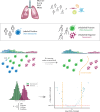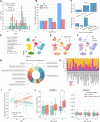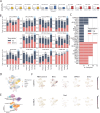This is a preprint.
SenSet, a novel human lung senescence cell gene signature, identifies cell-specific senescence mechanisms
- PMID: 40692702
- PMCID: PMC12279080
- DOI: 10.1101/2024.12.21.629928
SenSet, a novel human lung senescence cell gene signature, identifies cell-specific senescence mechanisms
Abstract
Cellular senescence is a major hallmark of aging. Senescence is defined as an irreversible growth arrest observed when cells are exposed to a variety of stressors including DNA damage, oxidative stress, or nutrient deprivation. While senescence is a well-established driver of aging and age-related diseases, it is a highly heterogeneous process with significant variations across organisms, tissues, and cell types. The relatively low abundance of senescence in healthy aged tissues represents a major challenge to studying senescence in a given organ, including the human lung. To overcome this limitation, we developed a Positive-Unlabeled (PU) learning framework to generate a comprehensive senescence marker gene list in human lungs (termed SenSet) using the largest publicly available single-cell lung dataset, the Human Lung Cell Atlas (HLCA). We validated SenSet in a highly complex ex vivo human 3D lung tissue culture model subjected to the senescence inducers bleomycin, doxorubicin, or irradiation, and established its sensitivity and accuracy in characterizing senescence. Using SenSet, we identified and validated cell-type specific senescence signatures in distinct lung cell populations upon aging and environmental exposures. Our study presents the first comprehensive analysis of senescent cells in the healthy aging lung and uncovers cell-specific gene signatures of senescence, presenting fundamental implications for our understanding of major lung diseases, including cancer, fibrosis, chronic obstructive pulmonary disease, or asthma.
Figures







Similar articles
-
Prescription of Controlled Substances: Benefits and Risks.2025 Jul 6. In: StatPearls [Internet]. Treasure Island (FL): StatPearls Publishing; 2025 Jan–. 2025 Jul 6. In: StatPearls [Internet]. Treasure Island (FL): StatPearls Publishing; 2025 Jan–. PMID: 30726003 Free Books & Documents.
-
Therapeutic effects of PDGF-AB/BB against cellular senescence in human intervertebral disc.Elife. 2025 Jul 16;13:RP103073. doi: 10.7554/eLife.103073. Elife. 2025. PMID: 40668091 Free PMC article.
-
Methylglyoxal-induced glycation stress promotes aortic stiffening: Putative mechanistic roles of oxidative stress and cellular senescence.bioRxiv [Preprint]. 2025 Jan 6:2025.01.06.631561. doi: 10.1101/2025.01.06.631561. bioRxiv. 2025. PMID: 39829921 Free PMC article. Preprint.
-
Senotherapy for chronic lung disease.Pharmacol Rev. 2025 Jul;77(4):100069. doi: 10.1016/j.pharmr.2025.100069. Epub 2025 May 28. Pharmacol Rev. 2025. PMID: 40554265 Review.
-
The aged extracellular matrix and the profibrotic role of senescence-associated secretory phenotype.Am J Physiol Cell Physiol. 2023 Sep 1;325(3):C565-C579. doi: 10.1152/ajpcell.00124.2023. Epub 2023 Jul 24. Am J Physiol Cell Physiol. 2023. PMID: 37486065 Free PMC article. Review.
Cited by
-
SpatialCVGAE: Consensus Clustering Improves Spatial Domain Identification of Spatial Transcriptomics Using VGAE.Interdiscip Sci. 2025 Sep;17(3):497-518. doi: 10.1007/s12539-024-00676-1. Epub 2024 Dec 16. Interdiscip Sci. 2025. PMID: 39680300
-
The AP-1 factor JUNB correlates with poor survival of patients with esophageal adenocarcinoma.Sci Rep. 2025 Jul 23;15(1):26790. doi: 10.1038/s41598-025-07393-9. Sci Rep. 2025. PMID: 40701988 Free PMC article.
References
-
- Hayflick L. & Moorhead P. S. The serial cultivation of human diploid cell strains. en. Exp. Cell Res. 25, 585–621 (Dec. 1961). - PubMed
-
- Finkel T. & Holbrook N. J. Oxidants, oxidative stress and the biology of ageing. en. Nature 408, 239–247 (Nov. 2000). - PubMed
-
- Campisi J. & d’Adda di Fagagna F. Cellular senescence: when bad things happen to good cells. en. Nat. Rev. Mol. Cell Biol. 8, 729–740 (Sept. 2007). - PubMed
Publication types
LinkOut - more resources
Full Text Sources
